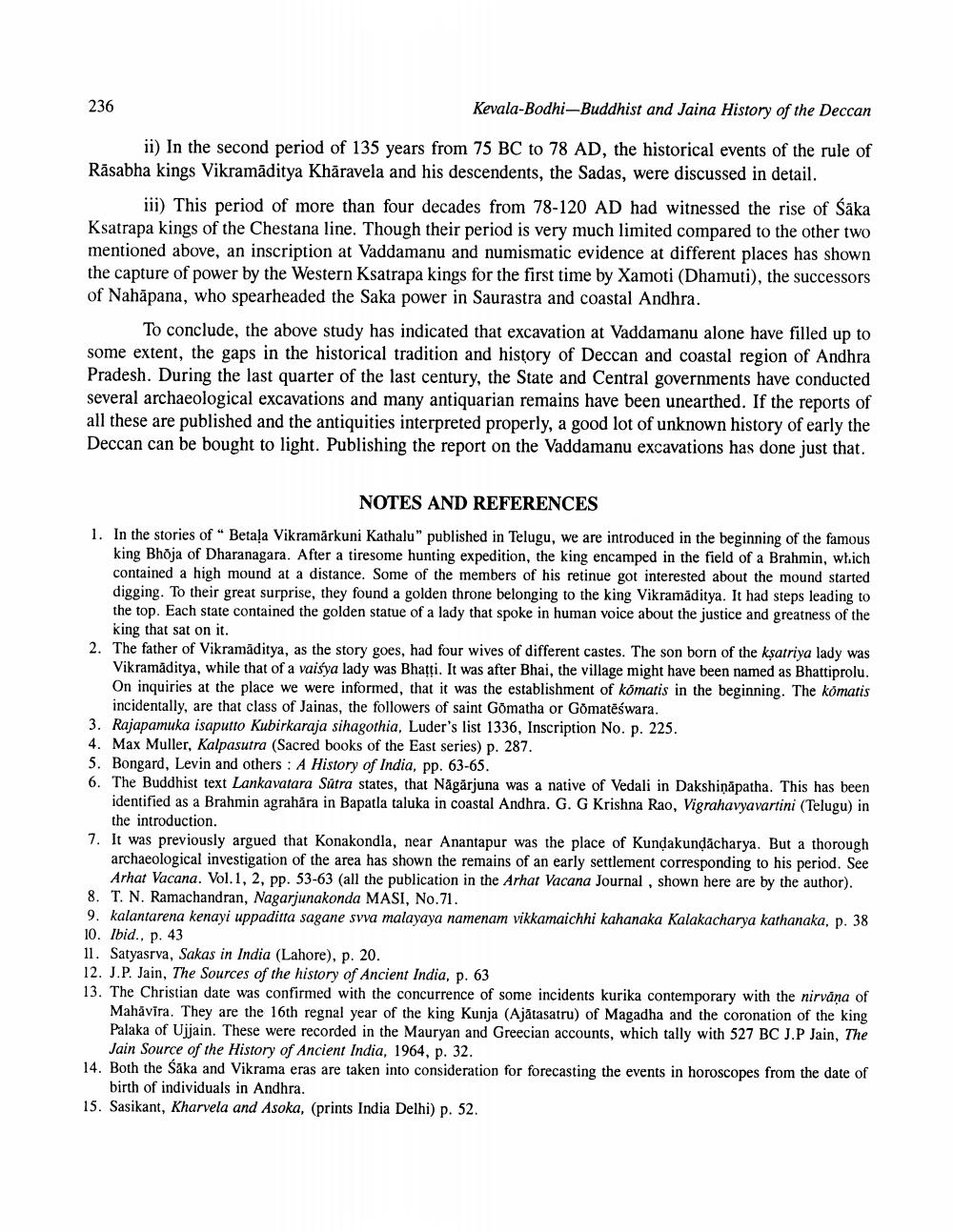________________
236
Kevala-Bodhi-Buddhist and Jaina History of the Deccan
ii) In the second period of 135 years from 75 BC to 78 AD, the historical events of the rule of Rasabha kings Vikramaditya Khāravela and his descendents, the Sadas, were discussed in detail.
iii) This period of more than four decades from 78-120 AD had witnessed the rise of Säka Ksatrapa kings of the Chestana line. Though their period is very much limited compared to the other two mentioned above, an inscription at Vaddamanu and numismatic evidence at different places has shown the capture of power by the Western Ksatrapa kings for the first time by Xamoti (Dhamuti), the successors of Nahāpana, who spearheaded the Saka power in Saurastra and coastal Andhra.
To conclude, the above study has indicated that excavation at Vaddamanu alone have filled up to some extent, the gaps in the historical tradition and history of Deccan and coastal region of Andhra Pradesh. During the last quarter of the last century, the State and Central governments have conducted several archaeological excavations and many antiquarian remains have been unearthed. If the reports of all these are published and the antiquities interpreted properly, a good lot of unknown history of early the Deccan can be bought to light. Publishing the report on the Vaddamanu excavations has done just that.
NOTES AND REFERENCES 1. In the stories of " Betaļa Vikramārkuni Kathalu" published in Telugu, we are introduced in the beginning of the famous
king Bhoja of Dharanagara. After a tiresome hunting expedition, the king encamped in the field of a Brahmin, which contained a high mound at a distance. Some of the members of his retinue got interested about the mound started digging. To their great surprise, they found a golden throne belonging to the king Vikramaditya. It had steps leading to the top. Each state contained the golden statue of a lady that spoke in human voice about the justice and greatness of the
king that sat on it. 2. The father of Vikramaditya, as the story goes, had four wives of different castes. The son born of the ksatriya lady was
Vikramaditya, while that of a vaisya lady was Bhatti. It was after Bhai, the village might have been named as Bhattiprolu. On inquiries at the place we were informed, that it was the establishment of komatis in the beginning. The komatis
incidentally, are that class of Jainas, the followers of saint Gomatha or Gomatėśwara. 3. Rajapamuka isaputto Kubirkaraja sihagothia, Luder's list 1336, Inscription No. p. 225. 4. Max Muller, Kalpasutra (Sacred books of the East series) p. 287. 5. Bongard, Levin and others: A History of India, pp. 63-65. 6. The Buddhist text Lankavatara Sutra states, that Nagarjuna was a native of Vedali in Dakshiņāpatha. This has been
identified as a Brahmin agrahāra in Bapatla taluka in coastal Andhra. G. G Krishna Rao, Vigrahavyavartini (Telugu) in
the introduction. 7. It was previously argued that Konakondla, near Anantapur was the place of Kundakundācharya. But a thorough
archaeological investigation of the area has shown the remains of an early settlement corresponding to his period. See
Arhat Vacana. Vol.1, 2, pp. 53-63 (all the publication in the Arhat Vacana Journal, shown here are by the author). 8. T. N. Ramachandran, Nagarjunakonda MASI, No.71. 9. kalantarena kenayi uppaditta sagane svva malayaya namenam vikkamaichhi kahanaka Kalakacharya kathanaka, p. 38 10. Ibid., p. 43 11. Satyasrva, Sakas in India (Lahore), p. 20. 12. J.P. Jain, The Sources of the history of Ancient India, p. 63 13. The Christian date was confirmed with the concurrence of some incidents kurika contemporary with the nirvana of
Mahāvīra. They are the 16th regnal year of the king Kunja (Ajātasatru) of Magadha and the coronation of the king Palaka of Ujjain. These were recorded in the Mauryan and Greecian accounts, which tally with 527 BC J.P Jain, The
Jain Source of the History of Ancient India, 1964, p. 32. 14. Both the saka and Vikrama eras are taken into consideration for forecasting the events in horoscopes from the date of
birth of individuals in Andhra. 15. Sasikant, Kharvela and Asoka, (prints India Delhi) p. 52.




